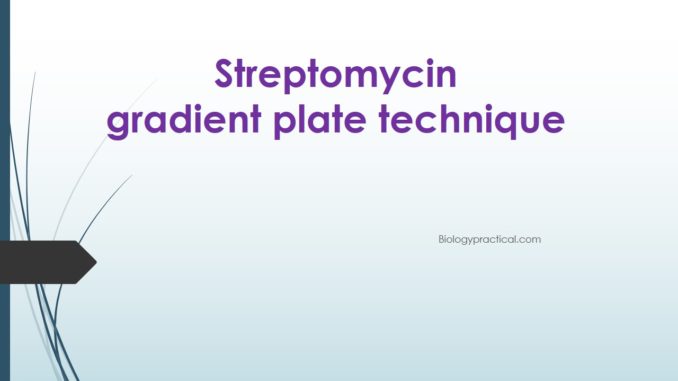
Objectives:
- To prepare streptomycin gradient agar plate
- To isolate streptomycin resistant variant of E. coli
Principle:
A microorganism that manifests a natural, nonmutated inheritance is termed as a wild type or wild strain whereas a mutant strain refers to the altered form. Mutant strains can show difference in morphology, nutritional characteristics, genetic control mechanisms, resistance to chemicals, temperature preference and nearly any type of enzyme function. Applications of mutant strains are in to trace genetic events, untangling genetic organization and pinpointing genetic markers.
Genetic and biochemical examinations are often commenced by the isolation of mutants. In order to detect mutants of a particular organism, one must know the normal or wild characteristics so as to identify an altered phenotype. Since mutants are generally rare, about one per 107 to 1011 cells, it is necessary to have a very sensitive detection system so that rare events will not be missed. Detection systems in bacteria and other haploid organisms are straight forward because any new allele should be seen immediately, even if it is a recessive mutation.
Phenotype refers to the noticeable characteristics of the organism and the genotype refers to the genetic makeup of an organism. Genes are designated by a three-letter code written in roman letters where first letter is capital, e.g. Abc. The genotypes of different isolates (occurrences) of a mutant with an Abc phenotype maybe designated abc-1, abc-2, etc. Wild type alleles of a gene are alloted with a ‘+’ superscript as in abc+.
An outstanding way to determine the ability of organisms to produce mutants that are resistant to antibiotics is to grow them on a gradient-plate of a particular antibiotic. This method requires preparation of a double layered agar plate consisting of 2 different wedge- like layers of medium.
A bottom slanted plain agar medium and a top layer of agar medium with the antibiotic. Since the antibiotic is only on the top layer, it leans to differ with the lower layer producing a gradient of antibiotic concentration from low to high. For isolation of antibiotic resistant mutants of gram-negative enteric bacteria, the antibiotics generally used are rifampicin, streptomycin and nalidixic acid.
This experiment concerns with the isolation of streptomycin resistant mutants using a prototrophic Escherichia coli by the use of a simple gradient technique where streptomycin at the rate of 100ug/ml is added in the nutrient agar medium. Following a spread-plate inoculation of E. coli and incubation for 4-7 days, the development of bacterial colonies in the high streptomycin concentration region will be streptomycin-resistant mutants.
Requirements:
- 24-hr nutrient broth culture of Escherichia coli
- Two nutrient agar deep tubes (10ml per tube/culture)
- Streptomycin sulphate solution
- A beaker with 90% ethanol
- Sterile petri plates
- Sterile 1-ml pipette
- Glass rod spreader
- Water bath
- Glass marking pencil
Procedure A: Preparation of streptomycin gradient agar plate
- In a hot water bath, melt two Trypticase soy agar tubes. Cool and maintain at 45°C.
- Place a pencil under one end of a sterile Petri dish, pour in a sufficient amount of the mol- ten agar medium to cover the entire bottom surface, and allow to solidify in the slanted position.
- Using a sterile 1-ml pipette, add 0.1 ml of the streptomycin solution to a second tube of molten Trypticase soy agar. Mix by rotating the tube between the palms of your hands.
- Place the dish in a horizontal position, pour in a sufficient amount of the molten agar medium containing streptomycin to cover the gradient agar layer, and allow to solidify.
Procedure B: observation of colonies and streaking
- With a sterile 1-ml pipette, add 0.2 ml of the E. coli test culture.
- With an alcohol-dipped and flamed bent glass rod, spread the culture over the entire agar surface.
- Incubate the appropriately labelled culture in an inverted position for 48 hours at 37°C.
- Observe the plate for the appearance of discrete colonies and indicate their positions in the “Initial Incubation” diagram in the Lab Report.
- Select one or two isolated colonies present in the middle of the streptomycin concentration gradient.
- With a sterile inoculating loop, streak the selected colonies toward the high- concentration end of the plate.
- Incubate the plate in an inverted position for 48 hours at 37°C.
Procedure C: isolation and identification of streptomycin resistant colonies
- Observe the plate for a line of growth from the streaked colonies into the area of high streptomycin concentration.
- Growth in this area is indicative of streptomycin-resistant mutants.
- Indicate the observed line(s) of growth in the “Second Incubation” diagram in the Lab Report.
Observations:
Observe the plate for the appearance of E. coli that are visible in the area of the low streptomycin concentration (LSC) and high streptomycin resistant (HSC) and count these and record the results. Examine each plate for a line of growth from the streaked colonies into the area of high streptomycin concentration.
Results Interpretation:
The colonies of E. coli that appear in the area of high streptomycin concentration will be streptomycin-resistant mutants. Select and mark an isolated colony of E. coli in the HSC area. Development of E. coli colonies in the HSC area designates the successful isolation of streptomycin-resistant mutants.

Precautions:
- Always label the bottom of the plate to show the low and high streptomycin concentration areas.
- The gradient-plate must be prepared at least 24hrs before inoculation to allow the formation of antibiotic gradient in the plate.
- Always grow the organism overnight in a rich broth.
- Don’t disturb the nutrient agar plate when kept in a slanted position, until complete solidification has occurred.
